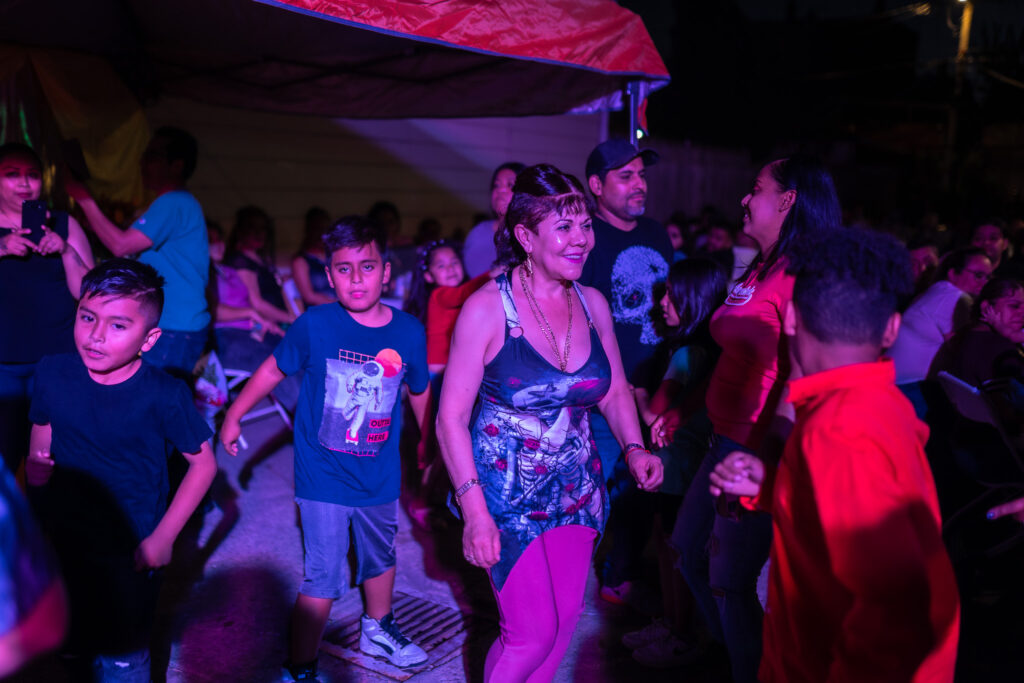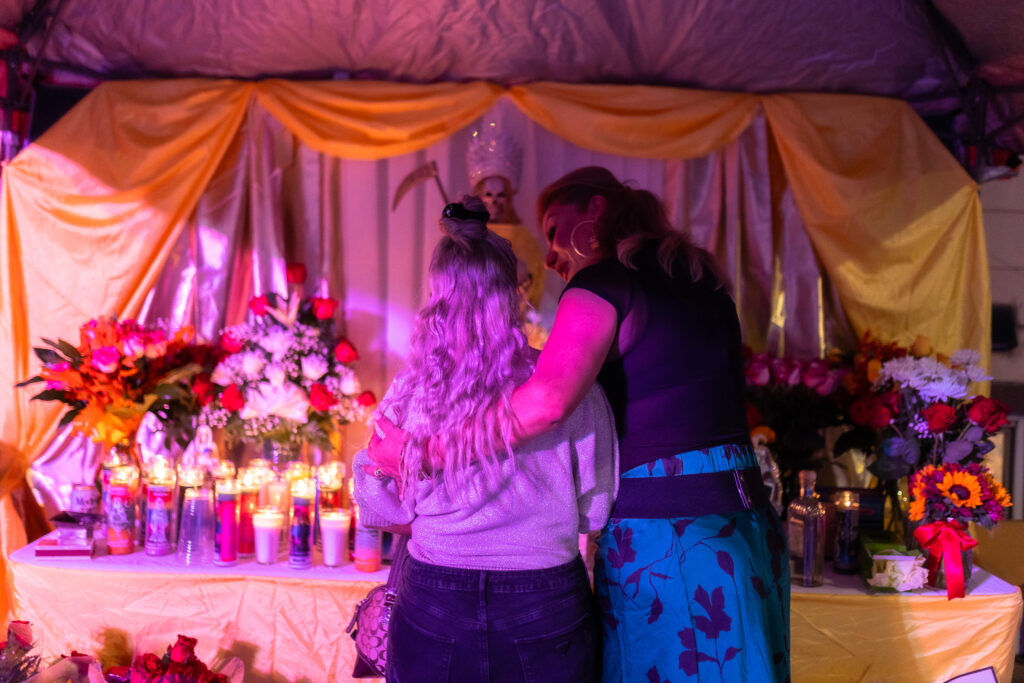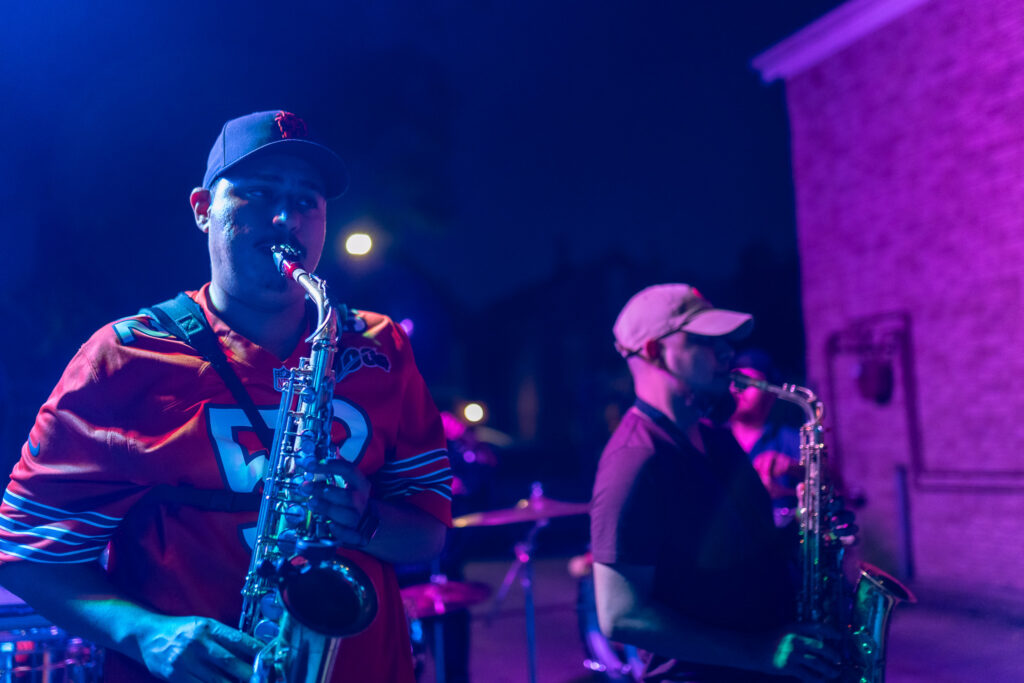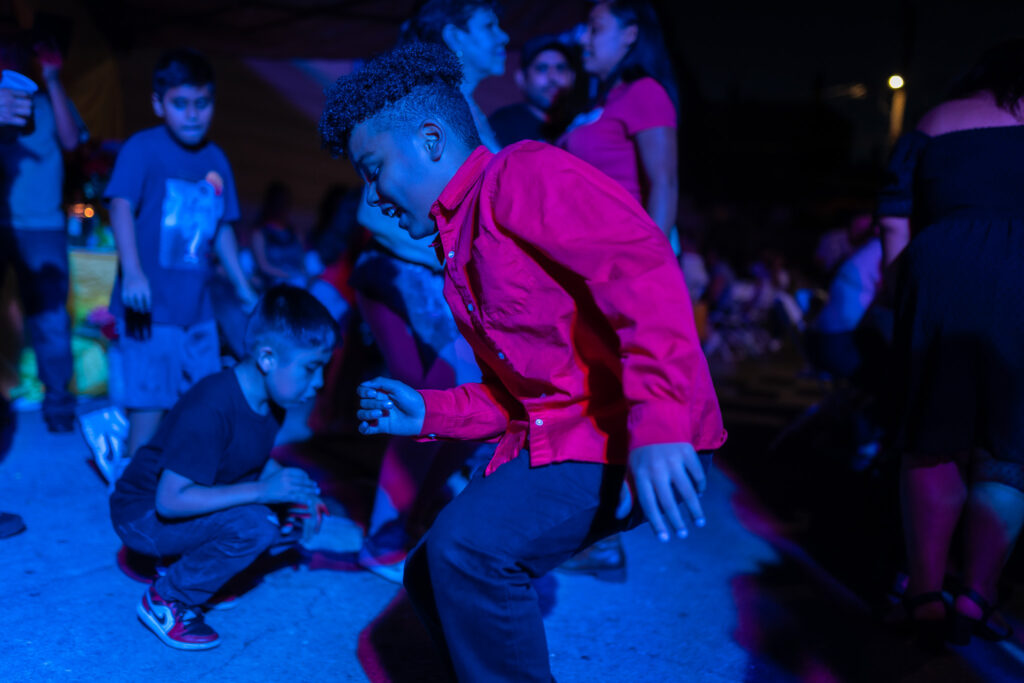At the heart of La Chaparrita Grocery, where generations have found cherished traditions packaged as goods, from De la Rosa mazapan candy to religious candles, a commanding female presence stands tall—la Santa Muerte, a skeleton-like folk saint often regarded as the goddess of death in Mexican culture.
Building on this legacy, La Chaparrita’s la Santa Muerte celebration invites all for a unifying experience. The store’s parking lot becomes a lively backdrop for festivities dedicated to her honor and the beloved taqueria.
Towering at the entrance of the grocery’s popular taqueria, joined with a family of small saints, la Santa Muerte watches over as taquero César Castillo masterfully prepares tacos de lengua (beef tongue) and other crowd favorites like sesos (brain), al pastor (pork), tripa (intestines) and spicy longaniza (sausage) on a sizzling round comal. Just a few steps away, Angelina Méndez, the owner, welcomes each customer with a warmth that for many feels like home.
“[Customers] return to a part of Mexico,” Méndez said. “They see our things and go, ‘Oh, look, do you remember this?’ But when they taste the tacos, they say, ‘You brought a flavor of tacos I haven’t eaten in 15 years.’ So, this is a little piece of Mexico. People find it here in Chicago at La Chaparrita.”
Since 2001, La Chaparrita at the intersection of 25th and Whipple Street in Chicago’s Little Village has been more than just a taqueria. Méndez, building on her mother Emma Pérez Díaz’s legacy, infused the place with her three-decade-long faith in la Santa Muerte and recipes from Mexico City. She made a promise to the saint: if the business flourished, she’d build an altar. Today, amidst the aroma of tacos, that altar stands, offering a space for devotees to express their faith, especially those who can’t do so at home.
“My original vow was that every first of November, I would have food at La Chaparrita, and every person who entered that day would leave with a plate of food,” Méndez said. “To me, offering food and inviting people to eat signifies giving abundance to you.”
For people who worship la Santa Muerte, November 1 is often celebrated as its saint’s day.
In a testament to the deep bond between the store and its community, La Chaparrita has made it a tradition to honor la Santa Muerte every year. On Sunday, they hosted their annual event, catering to their dedicated patrons.

Over the years, the event has experienced significant growth. While the store boasts a loyal customer base and serves a community of steadfast devotees to the religion, the owners emphasize that individuals from all religions and cultures are welcome.
Regarded as a saint symbolizing both death and protection among her followers, la Santa Muerte is believed to offer protection, healing and miracles. While her roots are in Mexico, her presence has touched souls throughout Latin America and the U.S.
Rocio Rueda, who resides in DuPage, said her journey with la Santa Muerte began more than a decade ago and her connection with La Chaparrita came after watching Netflix’s “Taco Chronicles” that featured the taco joint.
Her faith took root after an experience when she prayed for her lost goddaughter’s safe return and believes la Santa Muerte answered her plea.
Devotees like Rueda frequently offer gifts to la Santa Muerte, hoping for a favor in return, much like a spiritual agreement. Despite initial fears and a Catholic upbringing, she now relies on la Santa Muerte for protection and abundance.
“I grew up as a Catholic teacher,” Rueda said. “I grew up in the choir. I asked [la Santa Muerte], ‘If you are real and if you do exist, show me that you exist.’ And she gave me back my goddaughter.”
Reflecting on the event, Rueda shared how she discovered a strong sense of belonging within the event’s community. “All these people here—I love it,” Rueda said. “I thought I was the only one. I’m one in a hundred. And I see there’s many of them. They brought their children. They brought the elderly. They brought their spouses. They are second generation.”
At the recent celebration, some families gathered near an ornate yellow altar adorned with flowers and candles to honor la Santa Muerte. As nighttime fell, the sounds of mariachi and banda music resonated through the streets. Méndez served her popular home dishes from large pots, including mole verde, nopal with mushrooms and pork in morita salsa.
Draped in a golden robe, holding a scythe and wearing a gleaming crown, la Santa Muerte took center stage. Arely Vázquez, who dressed the saint, traveled from New York to help Méndez, her longtime friend, at the event. Two decades ago, Vázquez made a pact with la Santa Muerte after surviving a life-threatening health issue. She now passionately shares the saint’s prayers with others.
“Celebrations are a way of giving thanks to [la Santa Muerte] for everything she provides us with, primarily health, work and for helping us overcome the adversities that life presents us,” Vázquez said. “That is what’s important. And for this reason, we always show our gratitude in this way, by celebrating in her honor.”
Faces beamed with joy, and laughter filled the air as hundreds of attendees exchanged warm embraces and shared stories of mourning, dreams, and personal experiences. All were united by the collective healing brought about by their protector, la Santa Muerte.
“I [created the party] due to faith, out of gratitude and love for her, but I am very happy doing her party,” Méndez said. “I am very happy seeing people eat and enjoy [the party] and that people leave happy.”
Méndez recognizes the misconceptions surrounding la Santa Muerte and aims to enlighten visitors about her true significance. By showcasing her in the store, she encourages discussions, corrects myths and emphasizes la Santa Muerte’s spiritual value.
“[La Santa Muerte] is not evil,” Méndez said. “We all have faith in different saints. She is not vengeful. Many people think that if you ask her for something and don’t fulfill your promise to her, she will punish you with the death of a loved one. But that’s not the case. Because death does not make decisions when taking in souls, since she was not the creator. The only being that can [decide] to collect souls is God.”
La Santa Muerte has evolved over time, blending with elements from Roman Catholicism and Afro-Cuban Santería. Various theories surround her origin, from being a continuation of the Aztec death goddess Mictecacihuatl to emerging from Spanish colonial influences. The Mexican government and the Catholic church have opposed the religion’s history, leading non-followers to associate her with evil.
But for many followers, she represents a symbol of hope and guidance. La Santa Muerte devotees often view death as a means to live freely without fear.
Julie Duran, who recited the rosary at the event, said her journey with la Santa Muerte began when her mom introduced her to the saint, and despite being intimidated by the skeletal figure, she found her positive influence compelling.
“I think [la Santa Muerte] clears my mind,” Duran said. “I think it’s just like any other saint that Mexicans believe in. And I think it’s just because you believe so much in her, it just helps you open up.”
Duran emphasized that It’s crucial to seek knowledge on la Santa Muerte and not judge based on myths.
“A lot of us Mexicans are either Catholic or Christian,” Duran said. “But I also know priests that can’t openly say that they believe in her. But, it’s there. It’s death. ”
People expressed their devotion to la Santa Muerte in various ways. While many traditionally bring flowers, food and beer as tokens of admiration, including statues of saints like la Santa Muerte, others traveled from distant places to show their faith.
Coming all the way from Wisconsin, Ricardo Mena made it his mission to honor la Santa Muerte for all the blessings she has given him, like allowing him to keep his job.
“I light her candle and offer her flowers every day,” Mena said. “I don’t promise her things I can’t fulfill. I simply ask her to help me.”
Méndez, who has Mena as a loyal customer, noted that many customers seek la Santa Muerte’s assistance during difficult times or to achieve their goals.
“There are many people who have asked [la Santa Muerte] to help a sick family member, for their papers or for a legal issue they’ve had,” Méndez said. “Well, with their faith, they have succeeded in those requests. Most who believe in her don’t believe in doing illegal things to feel protected.”
Méndez’s vision for the future extends beyond the event and into the hands of her three grandchildren, who will one day run the shop. She believes Little Village is being revitalized and in the face of changing times, La Chaparrita will remain a beloved part of the community that is thriving and growing.
“I tell [my grandchildren] that they have to learn everything because they are going to be the managers of La Chaparrita,” Méndez said. “But, with a new renovation, not [changing] the taste of the tacos, but yes, [changing the shop] to something modern because this neighborhood is going to change.”
Next year’s event will continue to offer the same experience, with an ofrenda and rosary prayer in the first half of the evening, followed by live music later in the night, along with food provided by La Chaparrita. And for those who were unable to attend Sunday’s event, there’s an option to leave offerings during store hours.
Leslie Hurtado is a contributing reporter for Cicero Independiente. Her work was previously featured in the Weekly, where she covered the 2021 Cook County jail demolition and Chicago’s guaranteed income programs last year.







What an interesting article about La Santa Muerte and how her devotion has grown, especially among marginalized groups. I like how her connection to death is explained and how many people see her as a protective figure. Thank you for sharing this information!